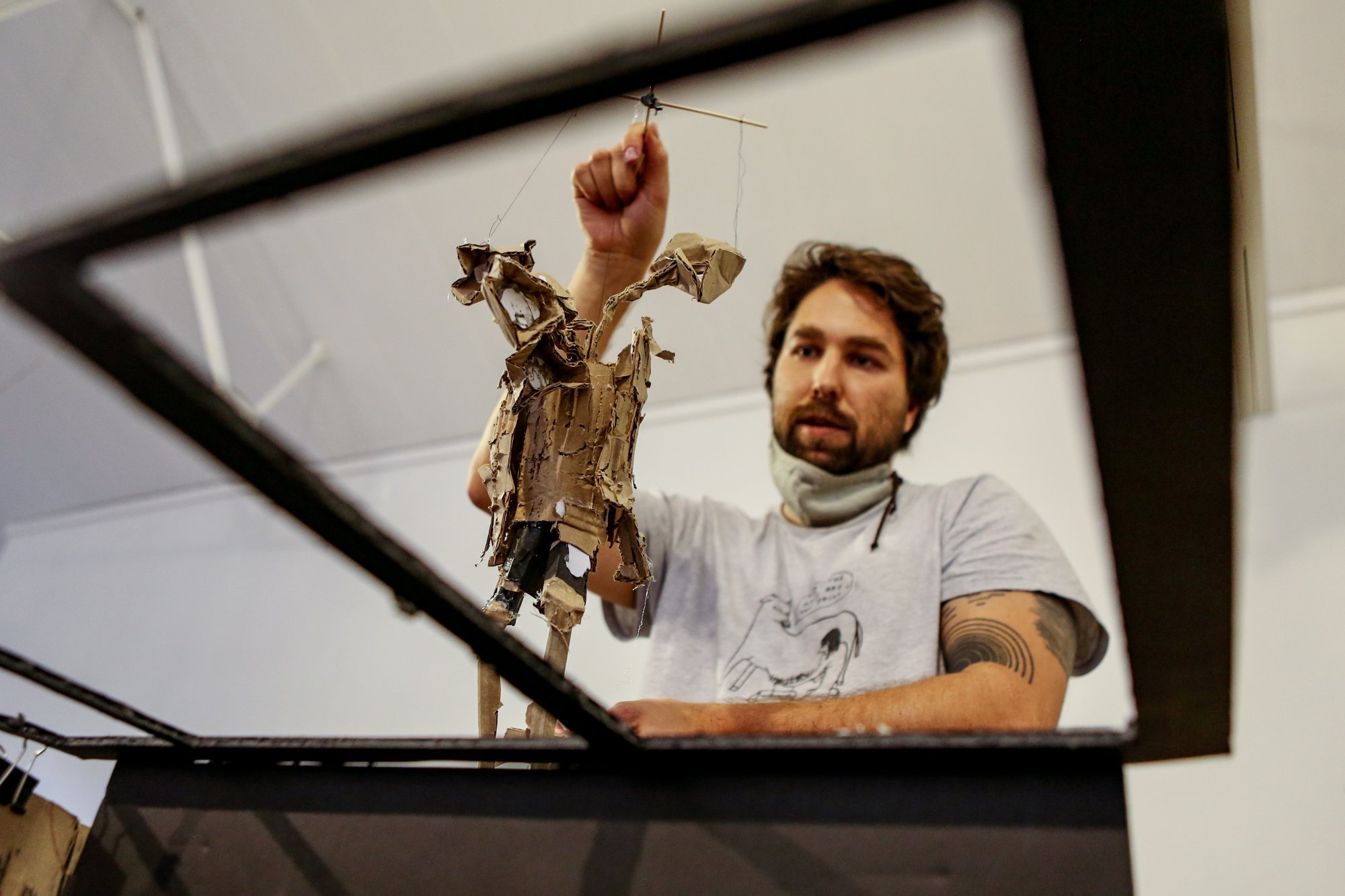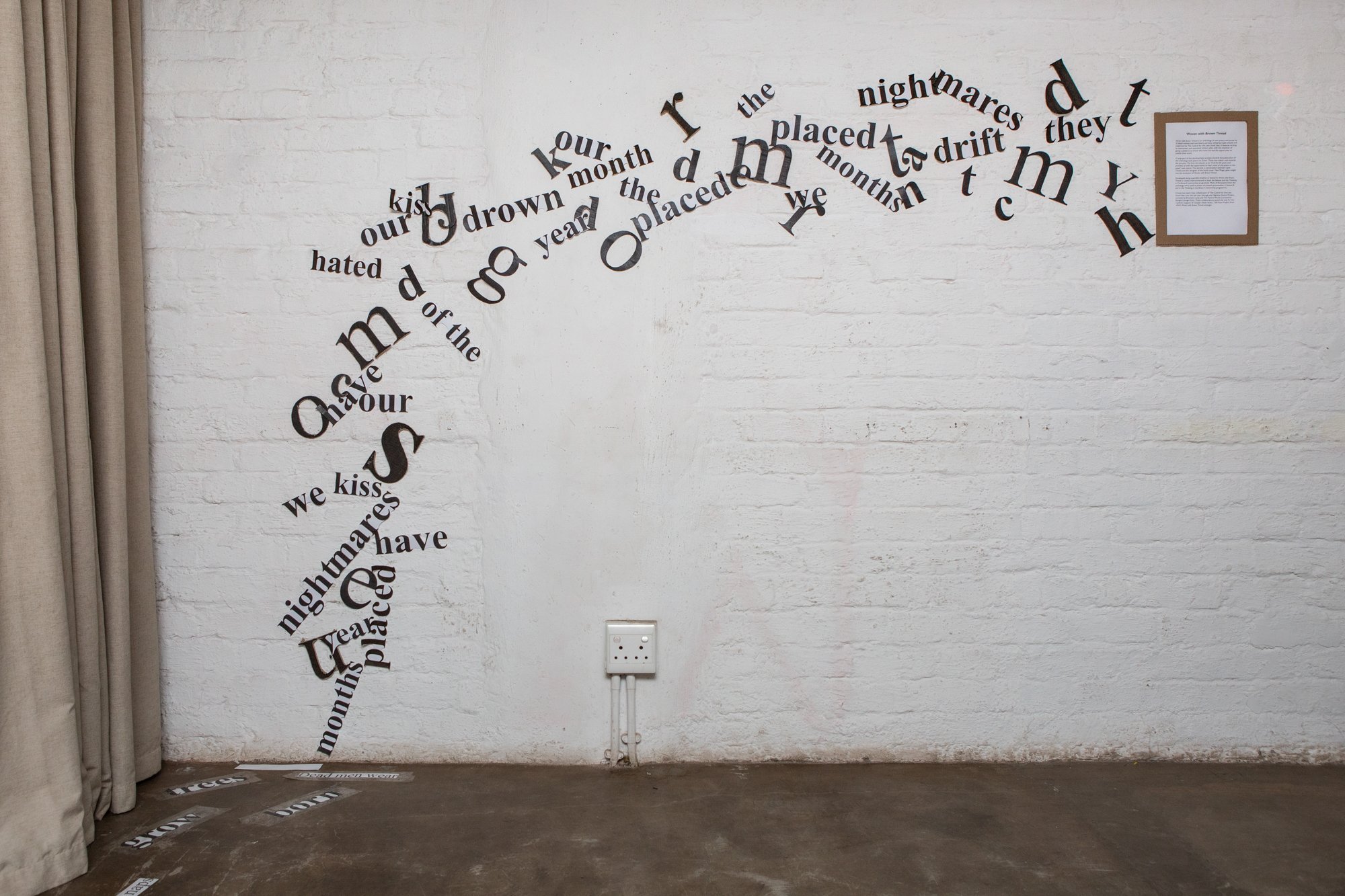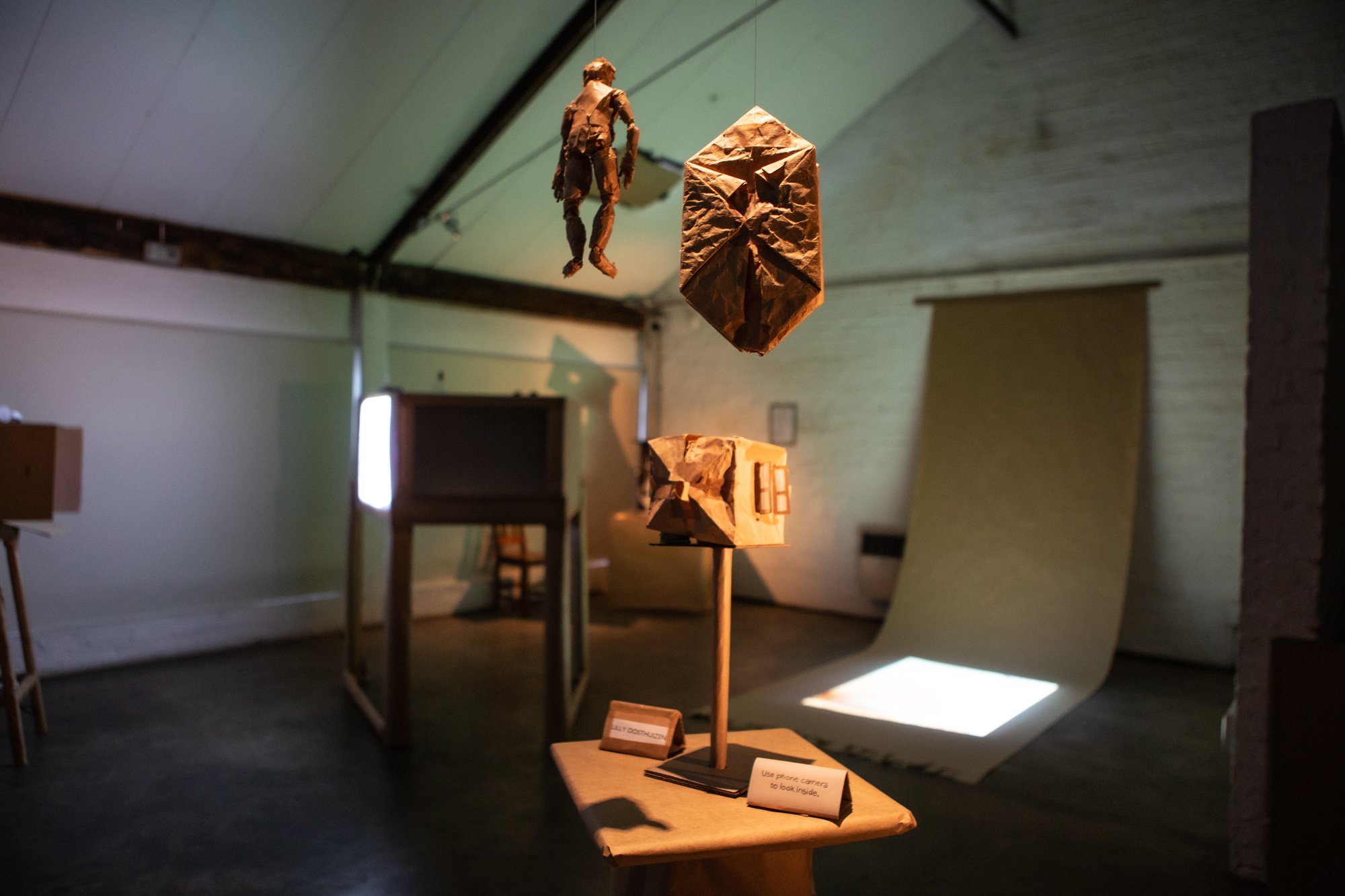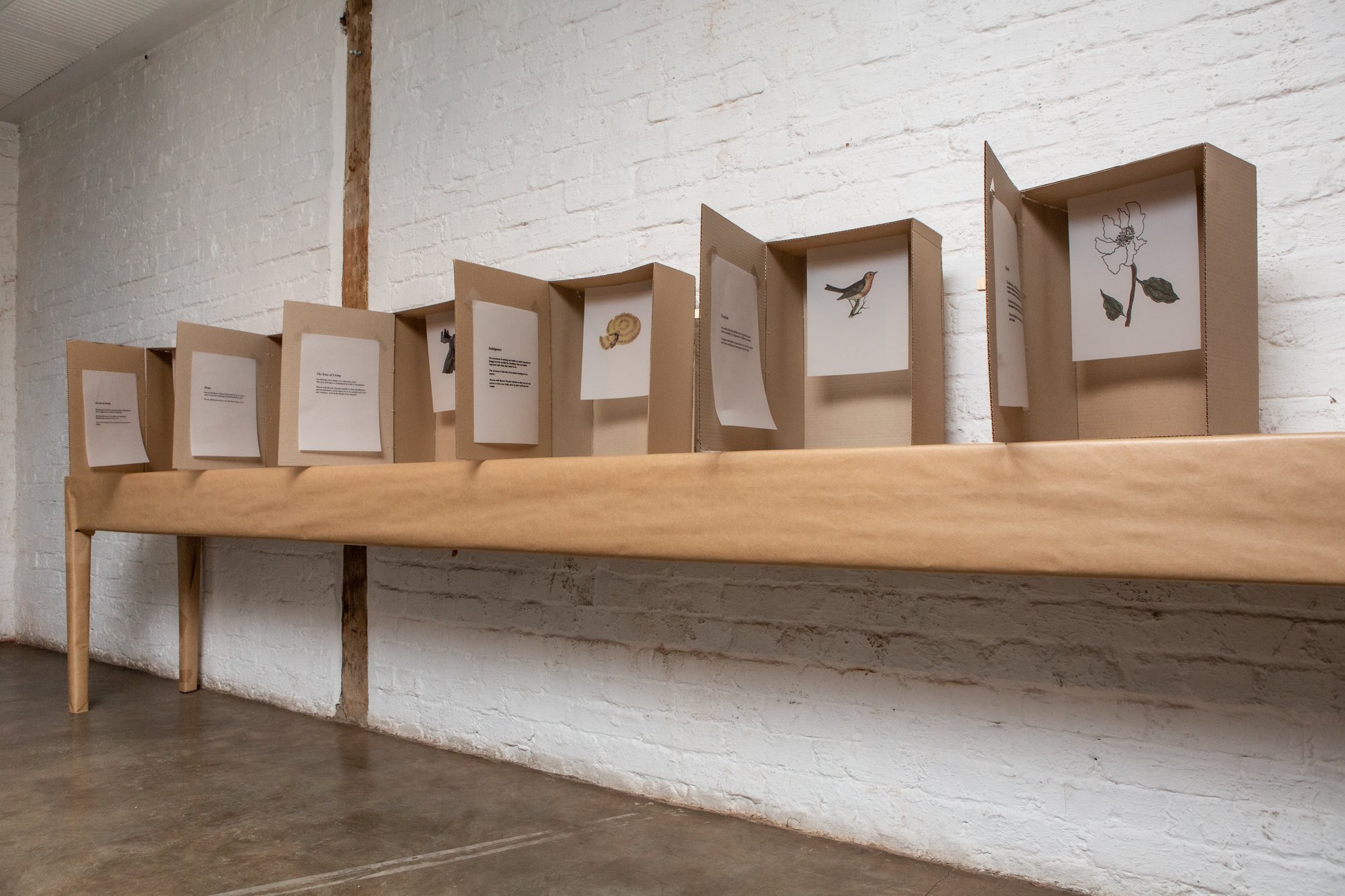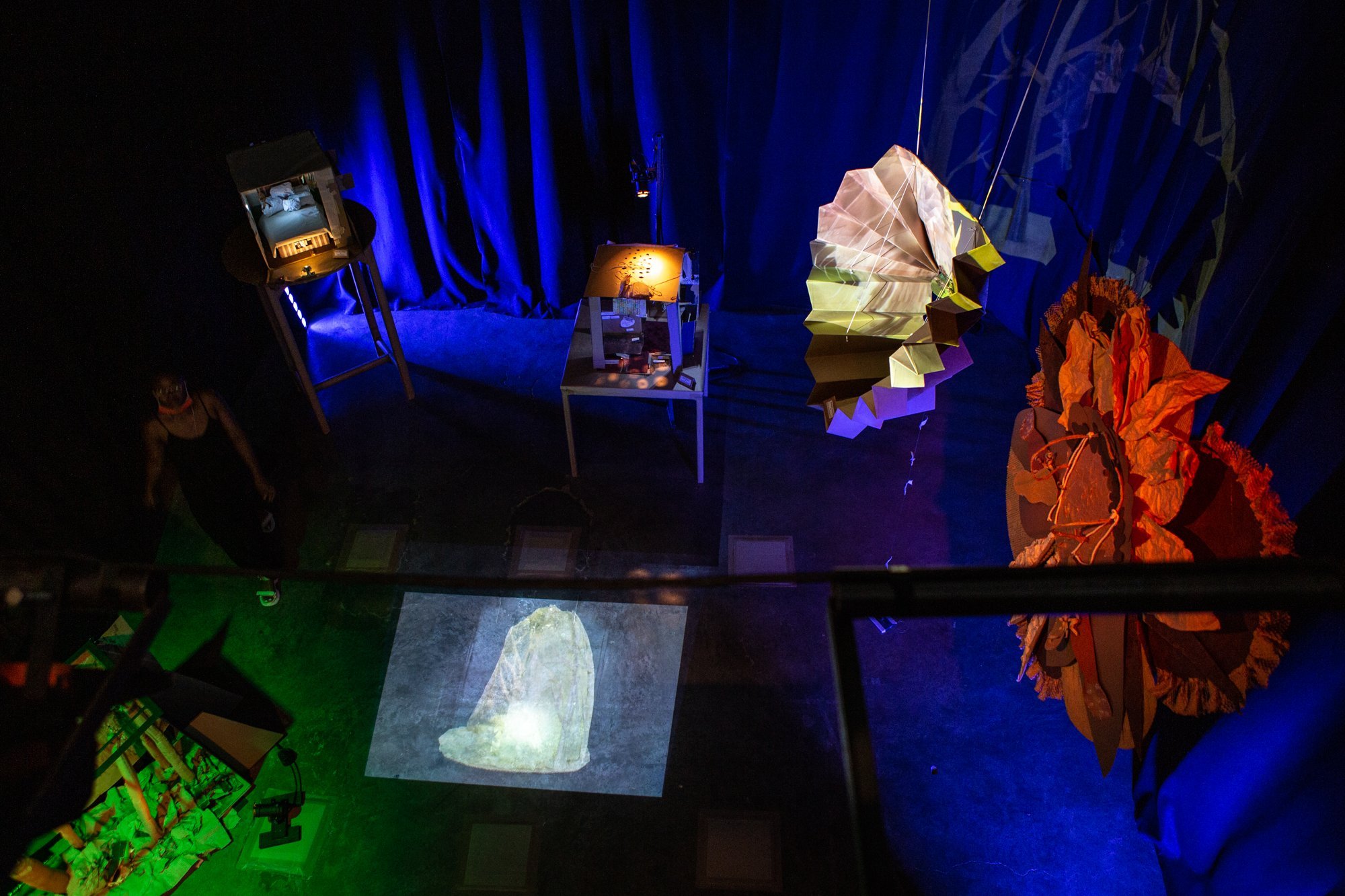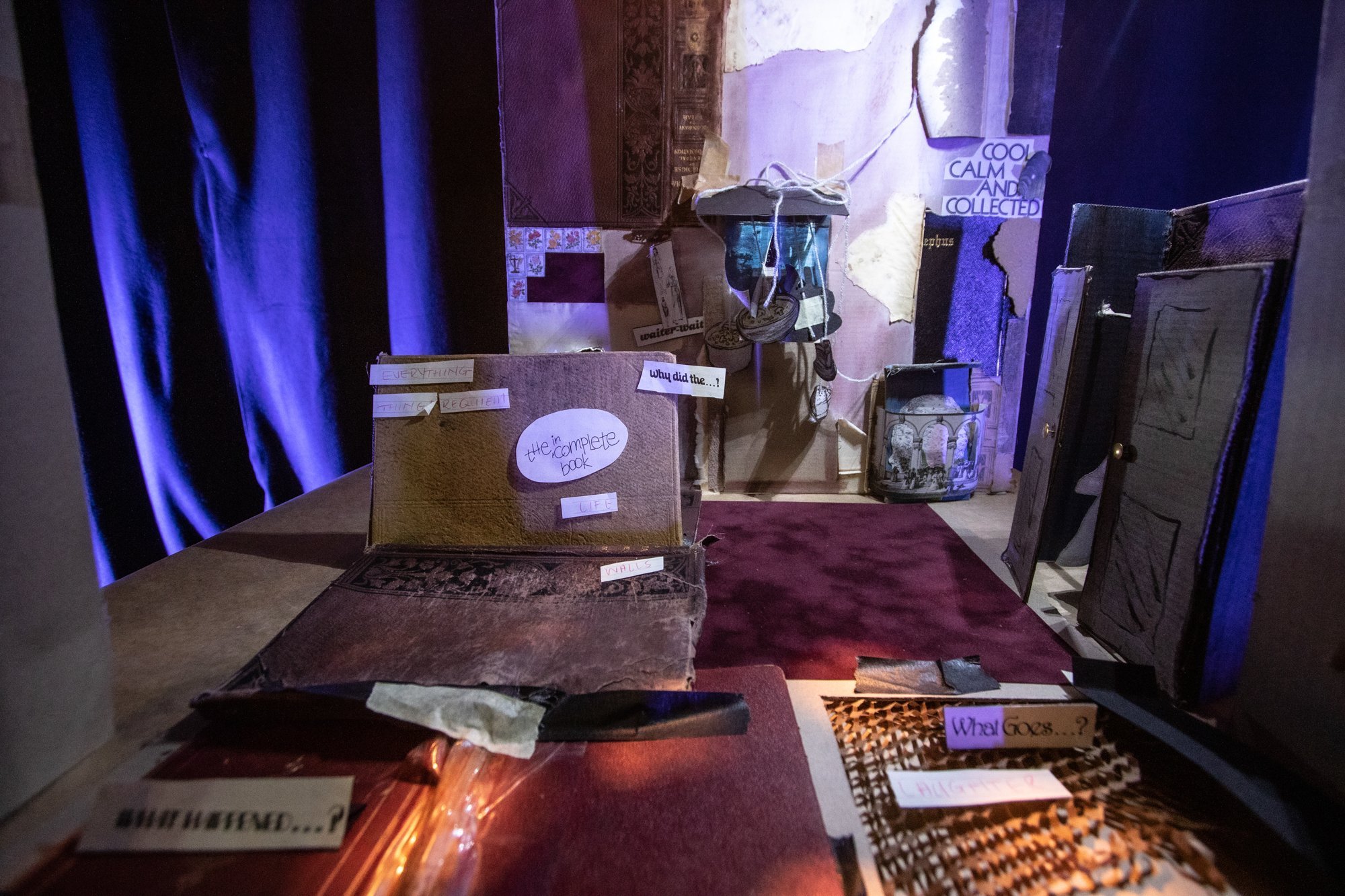THINKING IN CARDBOARD | A MENTORSHIP BY SABINE THEUNISSEN
What does it mean to think in cardboard? How can ideas undergo a process of folding, creasing and tearing, and what is the process of rendering tangible these ideas, these ways of conceptualising and seeing, through the tactile nature of cardboard?
In September 2021, The SO | Academy hosted the Thinking in Cardboard Mentorship programme. As part of The Centre for the Less Good Idea’s 8th Season, the 6-day programme saw 12 participants (based in Johannesburg and abroad) being mentored by Brussels-based artist and theatre, opera, dance and exhibition designer Sabine Theunissen.
For Theunissen, to think in cardboard is to embrace the intuitive and the repetitive through materiality. As such, her methodology prizes the intelligence of the hands, and pursues the tangible and the incidental through ways of working that, while imperceptible at first, find a rootedness in the material.
What emerges are tactile structures, visages and whole worlds in miniature. Through a literal and conceptual process of bending, cutting, folding, twisting and layering, there emerges something of a palimpsest – an archive of process and a physical model that holds its narrative in its material history.
Ways of seeing are crucial, too. To observe a room, a world, a universe in miniature is to identify and expand on its flaws and follies, its possibilities and its hidden potentials, in ways that are not possible through conventional methods of performance, architecture, or design.
The Thinking in Cardboard mentorship programme was produced in collaboration with the UNITA program and Scenography Today.
THE MENTORSHIP PROCESS
Guiding and mentoring 12 artists – six based in South Africa, and six from abroad – across various creative disciplines and time zones is no easy task. Considering the use of cardboard as a material provocation, and a generative and collaborative tool for thinking, new ways of working needed to emerge.
For Thinking in Cardboard mentor Sabine Theunissen, the logic and material tactics of collage became a way forward, both in terms of the structure of the mentorship programme and its practical and conceptual methodologies. Throughout the course of the programme it was the use of the found, the incidental, the intelligence and intuition of the hands, and the layered and fragmental possibilities of cardboard as a medium.
Theunissen embraced this distance between the mentees as a richness rather than a weakness. In this way, the mentorship programme harnessed the temporal and the situational to posit a process that was equal parts experiential and abstract. But it was also a process that pursued the material.
The 12 mentees were split into six teams of two – one Johannesburg-based and one internationally-based – and all of them paired carefully and deliberately. Theunissen paired mentees in ways that she felt could yield a particular chemistry or artistic dialogue, based on their backgrounds and interests. Each team was then tasked with using a poem from Woven with Brown Thread as a conceptual point of departure. Through the textual and thematic material of these poems, a common ground was found, and a set of emotions, interests, or ideas were pursued. 14:00 (SAST) became the ‘golden hour’, a vital time to meet as a group, virtually, and discuss processes, ideas, and challenges. Theunissen was also deliberate in fostering a collaborative and integrated environment for all of the mentees. Live streams and virtual tours outside of these formal meeting times became vital in this regard.
Provocations and limitations
From the onset, necessary limitations to creative practice were put in place. In addition to the provocations of working with a poem and with cardboard (or paper as a derivative of cardboard) as the primary material, there was also the production of a cardboard model. This model, which could not exceed 50 cubic centimetres, was bound to being created in a timeframe of six days and would both inform and feature in a one-minute film that saw the material of cardboard and the conceptual points of inquiry come to life through a collage-style process of traditional film, animation, projection, layering and more. Finally, works were created with the challenge of conceptualising a third participant – be it an artist, a performance, or the public – who would be interacting with the model.
Under the mentorship of Theunissen, participants were encouraged to work intuitively, repetitively, to prize the intelligence of the hands, and to pursue the tangible and the incidental. Rather than demonstrate or direct, Theunissen opted to inform from the margins, working sensitively and with great care to make sense of, and help expand the worlds each team of mentees were producing.
Prizing the incidental and the unexpected
Above all else, it was Theunissen’s passion for the incidental and the unexpected – that which emerges in the act of making and of thinking through the hands – that resonated through, and informed much of the process. There was a dedicated effort to refuse measurement, precision and neat material resolution. Also, there emerged an inherent trust in the process and the material, a belief that all that one needs in order to work is already within one’s immediate environment.
Finally, while the space was an open, collaborative, and explorative one, Theunissen also worked to draw each mentee out of their preferred practice or way of working, striving always to open up the possibilities of the mind, the hands and the material. The resultant works are all distinct and accomplished models, each spanning the themes of scale, time, breath, presence, embodiment, physicality, revealing and concealing.
— David Mann
CREDITS:
Based in Brussels, Sabine Theunissen is a long-time collaborator of William Kentridge, and collaborates with directors, choreographers, and curators. She is frequently invited to lecture and teach in art and architecture schools across Europe. In 2017, Theunissen created her own studio, Le Squatelier, where she develops all her projects with her team, but also researches and creates experimental works. Theunissen is an ambassador and advisor of the UNITA Program at Scenography Today.
Marine Fleury is an architect, scenographer and set designer who worked as assistant to Theunissen during the Thinking in Cardboard mentorship programme. A long-time collaborator of Theunissen’s, Fleury assisted with many of the technical and conceptual aspects of the process, helping mentees with the finer details of cutting, sticking, and piecing together the material, and was vital in contributing to the techniques and conceptual approaches of assembling and making sense of the models.
The SO Academy mentees were Buhle Xhegwana (Johannesburg, SA), Joshua Stanley (Cape Town, SA), Neo Phage (Johannesburg, SA), Amy-Sue Lithgow (Johannesburg, SA), Lilly Oosthuizen (Johannesburg, SA), Natalie Hlogi Paneng (Johannesburg, SA), Beatrice O'Connell (Dublin, Ireland), Dian Suci Rahmawati (Yogyakarta, Indonesia), Inés Marcó (Buenos Aires, Argentina), Beatrice Scaccia (New York, USA), Xiyu Tomorrow (Hamburg, Germany), and Nicci Haynes (Ngunnawal Country, Australia).
Athena Mazarakis is the Momenteur for the SO Academy.
THINKING IN CARDBOARD SHORT FILMS
A core outcome of the Thinking in Cardboard mentorship programme was the production of a cardboard model by each of the six teams of mentees. Each model was integral to the mentorship programme and culminated in the creation of a short film. The materiality, form, style and tone of these films are also informed by, and developed through the cardboard models themselves, with a single poem also serving as a conceptual point of departure for each. As such, each film can be seen as a world in miniature, constructed from and intertwined with the models, the final works being brought to life through traditional film, animation, projection, layering and more.
BLACKBURN, SOUTH POINT STUDENT ACCOMMODATION
POEM | Blackburn, South Point Student Accommodation by Zizipho Bam
CONCEPTUALISERS & CREATORS | Beatrice O’Connell & Buhle Xhegwana
BREATHE IN BREAK OUT
POEM | Day Break by Ashley Rose Scantlebury
CONCEPTUALISERS &CREATORS |Lilly Oosthuizen & Nicci Haynes
HIDDEN BEAUTIES
POEM | Hidden Beauties by Elodie Parthenay
CONCEPTUALISERS & CREATORS | Dian Suci Rahmawati & Natalie Paneng
COMPILATION
THINGS – AN EXERCISE IN MEMORY
POEM | Things by Lewa Letsogile
CONCEPTUALISERS & CREATORS | Beatrice Scaccia & Neo Phage
COMPOSER | Roberto Pistolesi
SUNDAY AFTERNOONS
POEM | Sunday Afternoons by Lewa Letsogile
CONCEPTUALISERS & CREATORS| Amy-Sue Lithgow & Inés Marcó
MUSIC | Efêmera by Tulipa Ruiz
IN THE WOODS
POEM | Hidden Beauties by Elodie Parthenay
CONCEPTUALISERS & CREATORS | Joshua Stanley & Xiyu Tomorrow
OPEN STUDIO WITH KENTRIDGE & CO
In September 2021, The Centre for the Less Good Idea’s SO Academy hosted an Open Studio showcasing the processes and techniques that informed William Kentridge’s commission by the Lucerne Symphony Orchestra, Shostakovich Symphony No. 10. This Open Studio was presented by Kentridge and long-time collaborator, Sabine Theunissen – artist and theatre, opera, dance and exhibition designer – as part of the SO Academy’s Thinking in Cardboard Mentorship in collaboration with UNITA Program and Scenography Today. The event was open and available to the broader public via live stream.
THINKING IN POETRY AND CARDBOARD EXHIBITION
In addition to the performance programmes of Season 8 of The Centre for the Less Good Idea, a multi-media exhibition was on show for the duration of the Season, and subsequently extended to 25 November.
The exhibition, titled Thinking in Poetry and Cardboard, features cardboard models and short videos created through the Thinking in Cardboard Mentorship Programme, short videos from the Poetry Minute series curated by Bongile Gorata Lecoge-Zulu, and videos showcasing the poetry of Woven with Brown Thread, an anthology as part of the Khala Series | 100 Poem project.
EXHIBITION WALKTHROUGH
CREDITS:
CURATOR | Athena Mazarakis
CURATORIAL ASSISTANT & DESIGNER | Neo Phage
CONSTRUCTOR & TECHNICAL DIRECTOR | Cue Lighting & Sound: Barry Strydom
INSTALLATION ASSISTANTS | Buhle Xhegwana, Amy-Sue Lithgow & Lilly Oosthuizen
Text and tactility: An archive of process
Text and tactility are the entry points to the SO | Academy’s Thinking in Poetry and Cardboard exhibition. It is words which lead you into the exhibition, pasted on the floor like a narrative map and moving along the walls, guiding you through the space.
Activating the space is a series of audio-visual works. Poetry is spoken, read, and recited while a collection of cardboard works are placed throughout the exhibition – they are sculptures, rooms, whole worlds in miniature. It is a tapestry of tangible and intangible things, the textured and the textual, towards the core themes, provocations, and processes of The Centre for the Less Good Idea.
Altogether, the Thinking in Poetry and Cardboard exhibition features cardboard models and short videos created through the Thinking in Cardboard Mentorship Programme led by international artist Sabine Theunissen, short videos from the Poetry Minute series curated by Bongile Gorata Lecoge-Zulu, and videos showcasing the poetry of Woven with Brown Thread, an anthology as part of the Khala Series | 100 Poem project curated by Upile Chisala.
The poems of the Woven with Brown Thread anthology were also key to the Thinking in Cardboard Mentorship Programme, with the starting point for each pair of mentees’ creative investigation being the selection of one of the poems from the anthology.
As such, the exhibition functions as an archive of process. Split across two levels, the exhibition brings into conversation the elements that have run parallel, or been central to, the development of Season 8 of The Centre – breath, mythology, poetry, language, translation and more.
Up the stairs, and on the stairs themselves, more texts guide you to The Poetry Minute videos and the remainder of the cardboard models. Throughout it all, there is the tangible presence of cardboard, tape, film, layering and paper, complimented by the sounds and the visuals of poetry and language. It is an immersive and experiential exhibition, showcasing artistic work and process in equal measure.
— David Mann
PHOTOGRAPHER | Zivanai Matangi




